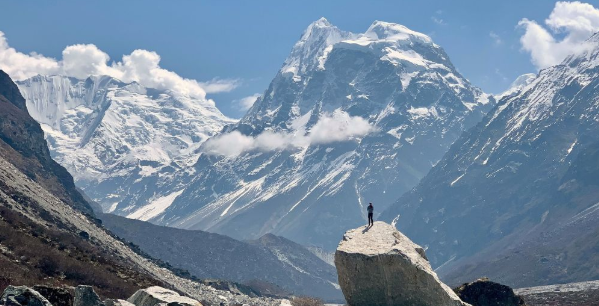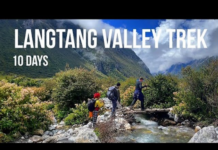The Langtang Valley Trek is one of Nepal’s most beautiful yet underrated trekking routes. Often called the “Valley of Glaciers,” Langtang lies just north of Kathmandu, near the Tibetan border. It offers a perfect blend of natural beauty, cultural richness, and Himalayan adventure without the crowds found on more commercial treks like Everest or Annapurna. The trek is ideal for those seeking a moderate journey through stunning landscapes and traditional mountain villages while still experiencing authentic Himalayan life.
Overview of the Langtang Valley Trek
The Langtang region is part of the Langtang National Park, Nepal’s first Himalayan national park, established in 1976. The area is famous for its snow-capped peaks, yak pastures, rhododendron forests, and Tibetan-influenced culture. Despite being relatively close to Kathmandu — just a seven-hour drive — the valley feels wonderfully remote and serene.
The trek typically takes 7 to 10 days to complete, reaching an altitude of around 4,984 meters at Tserko Ri, the highest viewpoint. From there, trekkers are rewarded with breathtaking panoramas of Langtang Lirung (7,234m), Ganesh Himal (7,422m), and other Himalayan giants.
Highlights of the Langtang Valley Trek
- Panoramic views of snow-covered peaks, glaciers, and valleys.
- Explore Kyanjin Gompa, a historic Buddhist monastery surrounded by mountains.
- Hike to Tserko Ri or Kyanjin Ri for sunrise views over Langtang Lirung.
- Experience the warm hospitality of Tamang and Sherpa communities.
- Walk through forests of rhododendron, bamboo, and pine.
- Visit yak cheese factories and taste fresh Himalayan cheese.
- Witness authentic Tibetan Buddhist culture and local traditions.
Typical Langtang Valley Trek Itinerary
Day 1: Drive from Kathmandu to Syabrubesi (1,550m)
The journey begins with a scenic drive through hills, terraced fields, and river valleys. Syabrubesi is the starting point of the trek and the main gateway to Langtang National Park.
Day 2: Trek to Lama Hotel (2,380m)
The trail follows the Langtang Khola River, passing through lush forests and suspension bridges. Expect to see monkeys, birds, and maybe even red pandas if you’re lucky.
Day 3: Lama Hotel to Langtang Village (3,430m)
As you ascend, the scenery opens up, offering glimpses of Langtang Lirung. Langtang Village was rebuilt after the 2015 earthquake and now welcomes trekkers with warm hospitality and improved lodges.
Day 4: Langtang Village to Kyanjin Gompa (3,870m)
A short but beautiful trek through yak pastures leads to Kyanjin Gompa, the spiritual and scenic heart of the Langtang Valley. You can visit the local monastery and a yak cheese factory here.
Day 5: Acclimatization and Hike to Tserko Ri (4,984m)
This is the highlight of the trek. An early morning hike to Tserko Ri rewards you with breathtaking views of the Langtang range, glaciers, and surrounding valleys. Return to Kyanjin Gompa for an overnight stay.
Day 6–7: Descend back to Syabrubesi via Lama Hotel
Retrace your steps through the forest and riverside trails. Enjoy your final night in Syabrubesi before heading back to Kathmandu.
Difficulty Level and Preparation
The Langtang Valley Trek is considered moderate, making it suitable for beginners with reasonable fitness. The trails involve both gradual ascents and some steep sections, but no technical climbing is required. The maximum altitude of about 5,000m means trekkers should be cautious about altitude sickness and take time to acclimatize properly.
Fitness Tips:
- Start light cardio and strength training 6–8 weeks before trekking.
- Practice hiking with a backpack for endurance.
- Stay hydrated and ascend gradually.
Best Time to Trek in Langtang Valley
The best seasons for the Langtang Valley Trek are spring (March–May) and autumn (September–November).
- Spring: Warm days, blooming rhododendrons, and clear skies.
- Autumn: Crisp air, stable weather, and crystal-clear mountain views.
- Winter (Dec–Feb): Cold but peaceful, with fewer trekkers.
- Monsoon (Jun–Aug): Lush landscapes but frequent rain and leeches.
Permits Required
To trek in Langtang Valley, you’ll need the following permits:
- Langtang National Park Entry Permit – NPR 3,000 per person.
- Trekker’s Information Management System (TIMS) Card – NPR 2,000 per person.
These can be obtained in Kathmandu through registered trekking agencies or at the park entry point in Syabrubesi.
Accommodation and Meals
The Langtang Valley Trek is a teahouse trek, meaning you’ll stay in small, family-run lodges offering basic yet comfortable rooms and hearty meals. Expect simple bedding, shared bathrooms, and delicious home-cooked food.
Common meals include:
- Dal Bhat (rice, lentil soup, and vegetables)
- Noodles and fried rice
- Tibetan bread and soup
- Momos (dumplings) and thukpa (noodle soup)
You can also enjoy yak cheese and butter tea — local specialties made fresh in the mountains.
Cultural Experience
The Langtang region is home to Tamang and Sherpa communities, whose culture is deeply influenced by Tibetan Buddhism. You’ll pass colorful prayer flags, chortens, and mani walls along the trail.
Villages like Langtang and Kyanjin Gompa have monasteries where monks chant daily prayers, and locals celebrate traditional festivals with music, dance, and rituals. This spiritual connection adds depth to the trekking experience, making it more than just a mountain walk.
Wildlife and Natural Diversity
Langtang National Park is rich in biodiversity, with over 1,000 plant species and 150 bird species. Trekkers may spot Himalayan tahr, musk deer, langurs, and red pandas along the way. The forests of oak, pine, and rhododendron create a colorful backdrop, especially during spring.
The region is also home to several glaciers, including the Langtang Glacier, which is easily accessible from Kyanjin Gompa. These natural wonders make the trek a paradise for photographers and nature lovers.
Langtang Valley After the Earthquake
The 2015 earthquake severely affected the Langtang region, destroying several villages and taking many lives. However, with the resilience of the local people and support from trekkers and NGOs, the area has been beautifully rebuilt. Trekking in Langtang now contributes directly to community recovery and sustainable tourism, making your visit meaningful.
Cost of the Trek
The cost of the Langtang Valley Trek typically ranges from $700 to $1,000, depending on the itinerary and services included. This usually covers:
- Accommodation and meals during the trek
- Guide and porter services
- Transportation from and to Kathmandu
- Permits and fees
Hiring a local guide not only ensures safety and navigation but also enriches your understanding of the region’s culture and history.
Why Choose the Langtang Valley Trek
The Langtang Valley Trek offers a perfect balance of natural beauty, cultural depth, and manageable adventure. It’s shorter and less crowded than other famous treks, yet equally rewarding. The proximity to Kathmandu makes it accessible, while the landscapes — from lush forests to icy peaks — make it unforgettable.
This trek is ideal for anyone who wants to experience the essence of the Himalayas without committing to a long or strenuous expedition.
Tips for Trekkers
- Carry warm clothing layers — temperatures drop quickly at higher altitudes.
- Always have cash, as ATMs are unavailable in remote areas.
- Bring a water purifier or tablets instead of buying plastic bottles.
- Respect local customs and avoid disturbing wildlife.
- Trek with a registered guide for safety and cultural insight.
Conclusion
The Langtang Valley Trek is a hidden treasure of Nepal that captures the true spirit of the Himalayas. With its combination of snow-capped mountains, ancient monasteries, and friendly local communities, it offers an experience that is both humbling and inspiring.
For travelers seeking peace, authenticity, and adventure, the Langtang Valley Trek is a journey of discovery — one where nature and culture blend perfectly, and every step brings you closer to the heart of Nepal.









